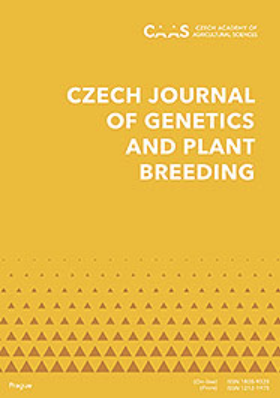Rabies virus glycoprotein produced in Nicotiana benthamiana is an immunogenic antigen in mice
IF 1.8
4区 农林科学
Q3 AGRONOMY
引用次数: 4
Abstract
Rabies remains an infectious disease among humans and animals, and requires the development of an effective vaccine essential to prevent rabies. Advances in molecular biology and biotechnology have led to the development and improvement of many rabies vaccines. Before the third-generation of the vaccine, rabies vaccines were based on the virus itself. Thus, even if effective, these vaccines may not be completely safe, resulting in a strong demand for the development of effective subunit vaccines that do not raise concerns about virus replication and infection in the host. This study investigated the ability of the glycoprotein of the rabies virus to be expressed in tobacco plants (Nicotiana benthamiana) and to induce an immune response in mice. Using a transient transfection, a soluble glycoprotein was successfully expressed in N. benthamiana. Fusing of five histidine residues at the C-terminus enabled the glycoprotein to be easily purified by affinity chromatography. The glycoprotein expressed in the plants was found to be N-glycosylated post-translationally, and the mice immunised with this glycoprotein generated neutralising antibodies against the rabies virus. These results suggest that a glycoprotein produced in the endoplasmic reticulum of N. benthamiana is bioactive, and might be used to generate a subunit vaccine against the rabies virus.本烟中产生的狂犬病毒糖蛋白是一种小鼠免疫原性抗原
狂犬病仍然是一种人类和动物之间的传染病,需要开发一种有效的疫苗来预防狂犬病。分子生物学和生物技术的进步导致了许多狂犬病疫苗的开发和改进。在第三代疫苗问世之前,狂犬病疫苗是以病毒本身为基础的。因此,即使有效,这些疫苗也可能不是完全安全的,这导致了对开发有效亚单位疫苗的强烈需求,这种疫苗不会引起对病毒在宿主中复制和感染的担忧。本研究研究了狂犬病病毒糖蛋白在烟草中表达和诱导小鼠免疫反应的能力。利用瞬时转染,一种可溶性糖蛋白在本氏N.benthamiana中成功表达。在C末端融合五个组氨酸残基使得糖蛋白能够容易地通过亲和层析纯化。发现植物中表达的糖蛋白在翻译后是N-糖基化的,用这种糖蛋白免疫的小鼠产生了针对狂犬病病毒的中和抗体。这些结果表明,本氏猪笼草内质网中产生的一种糖蛋白具有生物活性,可用于制备狂犬病病毒的亚单位疫苗。
本文章由计算机程序翻译,如有差异,请以英文原文为准。
求助全文
约1分钟内获得全文
求助全文
来源期刊

Czech Journal of Genetics and Plant Breeding
Agricultural and Biological Sciences-Plant Science
CiteScore
2.20
自引率
0.00%
发文量
25
审稿时长
>12 weeks
期刊介绍:
Original scientific papers, critical reviews articles and short communications from the field of theoretical and applied plant genetics, plant biotechnology and plant breeding. Papers are published in English.
 求助内容:
求助内容: 应助结果提醒方式:
应助结果提醒方式:


